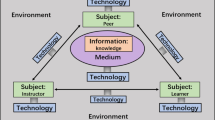Abstract
There have been numerous attempts to heighten the effects of education over the course of history. Currently, many relevant studies are being carried out on such issues as utilization of recently developed Information and Communication Technology (ICT) for education, which has become a global topic; efforts are being put into this movement at the national level. However, the systems to assist the efforts are not yet sufficient. Through this research, in this light, the Structured Plug-in Integrated Teaching and Learning Assistance System was developed, which aims to achieve affirmative results from ICT on education. This system can provide the instructor, learner, and their parents with a real-time monitoring system, intelligent tutoring system, collaborative education mechanism, e-Portfolio system, and digital material production method. Further, the system can be realized in the form of a Structured Plug-in. The system has been used in six classes of 219 fourth-year students in Korean elementary schools to analyze the system’s effects. In doing so, a questionnaire was developed and carried out on the students after the testing period. According to the results, the overall satisfaction level was 4.067 and the level of satisfaction on the content quality was 3.99, referring to ‘satisfaction’.







Similar content being viewed by others
References
Gromik, N. A. (2009). Cell phone video recording feature as a language learning tool: A case study. Computers and Education, 53, 1138–1146.
Shinde, V. V., & Inamdar, S. S. (2013). Problem based learning (PBL) for engineering education in India_need and recommendations. Wireless Personal Communication, 69, 1097–1105.
Santiprasitkul, Somporn, Sithivong, Kanjanee, & Polnueangma, Orathai. (2013). The first year nursing students achievement and critical thinking in local wisdom course using problem based learning process. Wireless Personal Communication, 69, 1077–1085.
Wang, Q. (2009). Design and evaluation of a collaborative learning environment. Computers and Education, 53, 1138–1146.
Yazidi, A., Granmo, O.-C., John Oommen, B., Gerdes, M., & Reichert, F. (2011). A user-centric approach for personalized service provisioning in pervasive environments. Wireless Personal Communication, 61, 543–566.
Zhang, L., Liu, Y., Zhan, X., Yang, X., Chi, X., & Zhao, S. (2012). An innovative location and context-aware video sharing application on smart phone. Wireless Personal Communication, 66, 493–509.
2010 e-Learning Industry Status Survey, Ministry of Knowledge Economy and National IT Industry Promotion Agency, 2011.
2009–2010 e-Learning White Paper, Ministry of Knowledge Economy & National IT Industry Promotion Agency & Korea Association of Consilience Education, Republic Korea, 2010.
2010 Hype Cycle for Education, Gartner.
Lee, J. (2011). The way to matching talent—a smart strategy to promote education. Ministry of Education Science and Technology, Republic Korea, June 27.
SK Telecom. Retrieved from http://www.sktelecom.com/press/list.do.
Xinics. Retrieved from http://support.xinics.com/support/index.php?mid=Presto.
Daul Soft. Retrieved from http://www.daulsoft.com.
Qrobo. Retrieved from www.qrobo.com.
Saltlux. Retrieved from www.saltlux.com.
SK Telecom. T Smart Learning. Retrieved from http://www.tsmartlearning.com/cls-main-web/index.html.
KT Olleh TV School. Retrieved from http://www.ktschool.co.kr/main/intro.do.
Samsung Media Solution Center. Retrieved from http://samsungtomorrow.com/1595.
SchoolCap. Retrieved from http://www.schoolcap.kr.
Kim, J. M. (2011). Curriculum evaluation based on middle school informatics textbook analysis. Ph.D. Graduate School at Korea University.
KERIS (2009). Adapting education to the information age 2008. Korea Education and Research Information Service (KERIS).
Acknowledgments
This work was supported by the Technology Innovation Program funded by the Ministry of Knowledge Economy (MKE, Korea) [1004850, Development of Structured Plug-in Software for Smart Education].
Author information
Authors and Affiliations
Corresponding author
Rights and permissions
About this article
Cite this article
Jo, J., Park, K., Lee, D. et al. An Integrated Teaching and Learning Assistance System Meeting Requirements for Smart Education. Wireless Pers Commun 79, 2453–2467 (2014). https://doi.org/10.1007/s11277-014-1765-4
Published:
Issue Date:
DOI: https://doi.org/10.1007/s11277-014-1765-4




